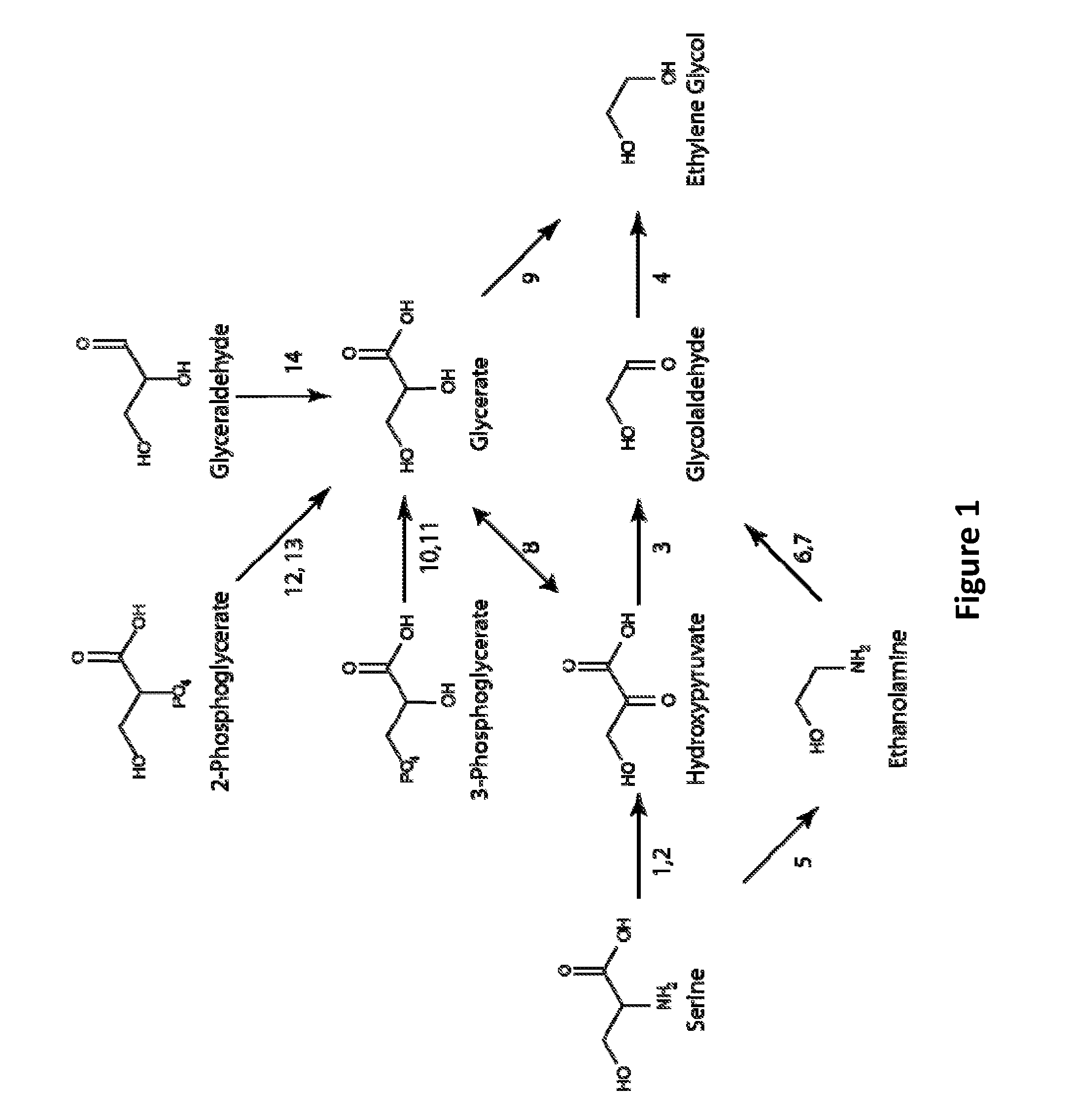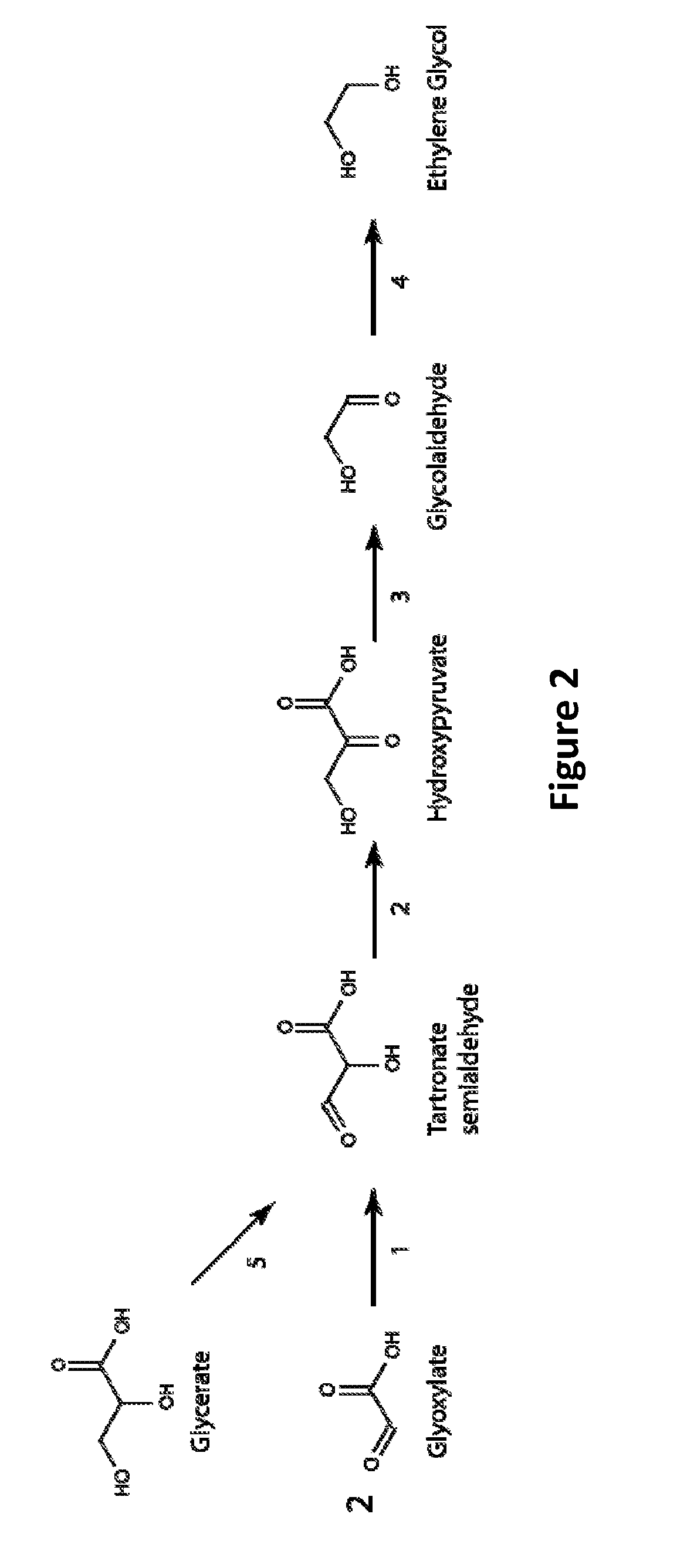Microorganisms and methods for the production of ethylene glycol
- Summary
- Abstract
- Description
- Claims
- Application Information
AI Technical Summary
Benefits of technology
Problems solved by technology
Method used
Image
Examples
example i
Pathways for Producing Ethylene Glycol from Serine
[0105]Several pathways are shown in FIG. 1 for synthesis of MEG from serine. In one embodiment serine is converted to hydroxypyruvate by a serine-hydroxypyruvate aminotransferase or a serine oxidoreductase (deaminating) (FIG. 1, Steps 1 or 2). Hydroxypyruvate is subsequently decarboxylated to glycoloaldehyde by hydroxypyruvate decarboxylase (FIG. 1, Step 3). Finally, glycolaldehyde is reduced to MEG by an aldehyde reductase (FIG. 1, Step 4). In an alternate route, the hydroxypyruvate intermediate is reduced to glycerate by hydroxypyruvate reductase, and subsequently decarboxylated yielding ethylene glycol (FIG. 1, Steps 8 and 9). In yet another pathway, serine is first decarboxylated to ethanolamine (FIG. 1, Step 5). This compound is subsequently converted to glycolaldehyde by a serine aminotransferase or oxidoreductase (deaminating) (FIG. 1, Steps 6 or 7). Exemplary enzyme candidates for serine pathway enzymes (Steps 1-9 of FIG. 1) ...
example ii
Pathways for producing ethylene glycol from 3-phosphoglycerate
[0116]Also shown in FIG. 1 are pathways to convert 3-phosphoglycerate (3PG) to ethylene glycol. In these pathways, 3-phosphoglycerate is first converted to glycerate by either a 3PG phosphatase or a glycerate kinase enzyme operating in the glycerate-generating direction (FIG. 1, Steps 10 or 11). Glycerate is then directly decarboxylated to ethylene glycol (FIG. 1, Step 9). Alternately, glycerate is oxidized to hydroxypyruvate (FIG. 1, Step 8), which is subsequently converted to ethylene glycol by the combined actions of hydroxypyruvate decarboxylase and glycolaldehyde reductase as described previously. Enzyme candidates for steps 10-11 of FIG. 1 are provided below.
[0117]3-Phosphoglycerate phosphatase (EC 3.1.3.38) catalyzes the hydrolysis of 3PG to glycerate, releasing pyrophosphate (FIG. 1, Step 10). The enzyme is found in plants and has a broad substrate range that includes phosphoenolpyruvate, ribulose-1,5-bisphosphate...
example iii
Pathways for Producing Ethylene Glycol from Glyoxylate Via Tartronate Semialdehyde
[0120]FIG. 2 shows a pathway for producing ethylene glycol from glyoxylate via a tartrate semialdehyde intermediate. The glyoxylate precursor may be derived from central metabolites such as isocitrate, via isocitrate lyase, or glycine, via one of several aminotransferase enzymes that utilize glycine as an amino donor such as serine:glyoxylate aminotransferase or glycine aminotransferase. In the proposed pathway, two equivalents of glyoxylate are joined by glyoxylate carboligase to form one equivalent of tartronate semialdehyde (FIG. 2, Step 1). Tartronate semialdehyde is subsequently isomerized to form hydroxypyruvate by hydroxypyruvate isomerase (FIG. 2, Step 2). The decarboxylation and reduction of hydroxypyruvate yield ethylene glycol as described previously (FIG. 2, Steps 3 and 4). Enzyme candidates for steps 1 and 2 of FIG. 2 are provided below.
[0121]Glyoxylate carboligase (EC 4.1.1.47), also know...
PUM
| Property | Measurement | Unit |
|---|---|---|
| period of time | aaaaa | aaaaa |
| of time | aaaaa | aaaaa |
| pressure | aaaaa | aaaaa |
Abstract
Description
Claims
Application Information
 Login to View More
Login to View More - R&D
- Intellectual Property
- Life Sciences
- Materials
- Tech Scout
- Unparalleled Data Quality
- Higher Quality Content
- 60% Fewer Hallucinations
Browse by: Latest US Patents, China's latest patents, Technical Efficacy Thesaurus, Application Domain, Technology Topic, Popular Technical Reports.
© 2025 PatSnap. All rights reserved.Legal|Privacy policy|Modern Slavery Act Transparency Statement|Sitemap|About US| Contact US: help@patsnap.com



